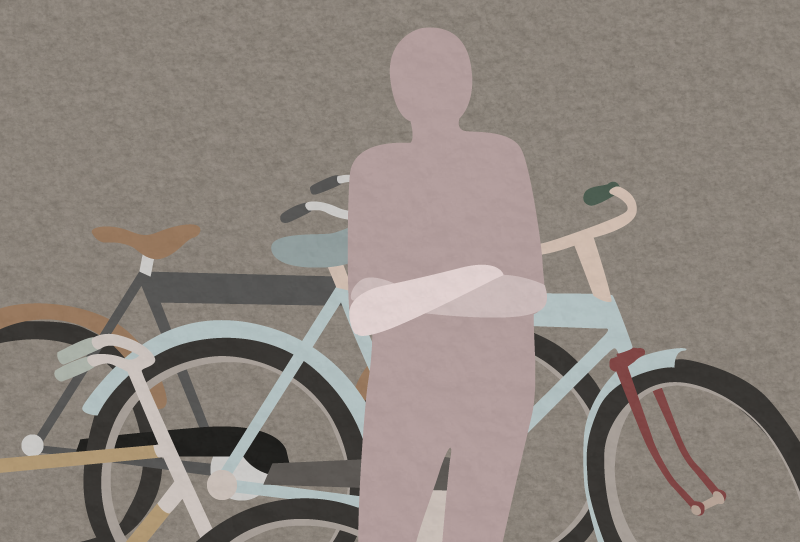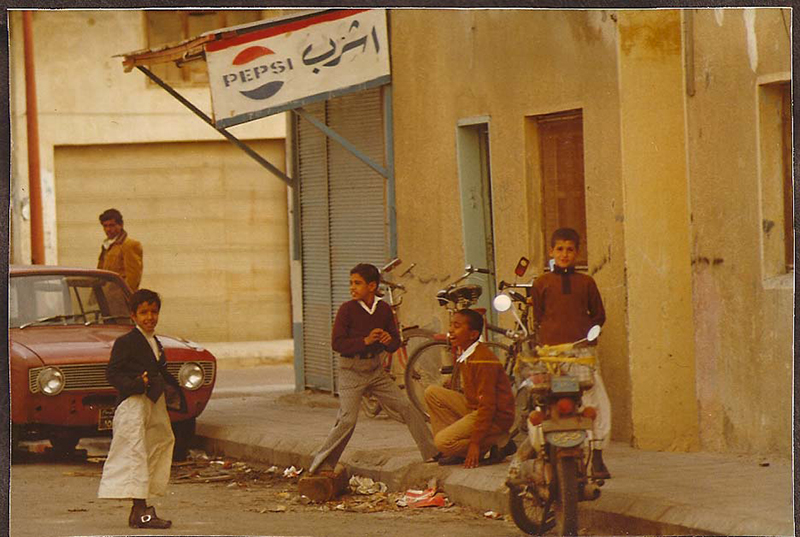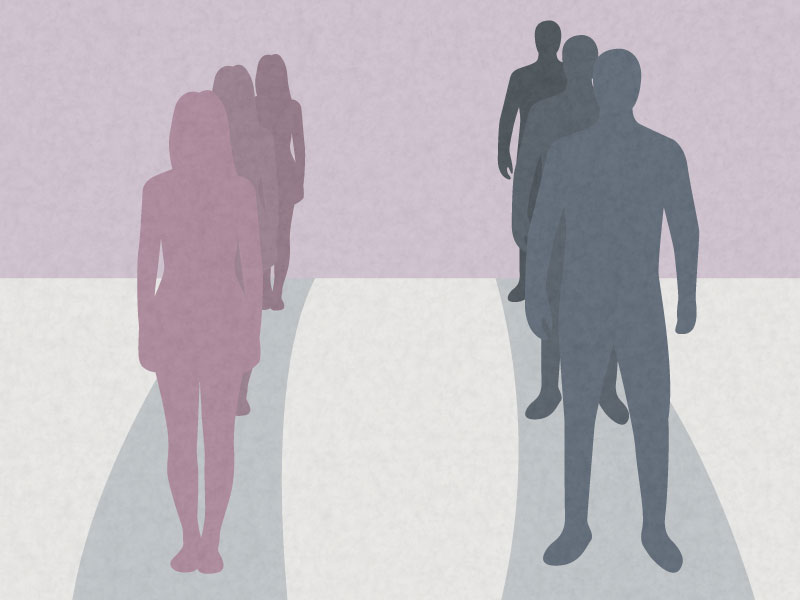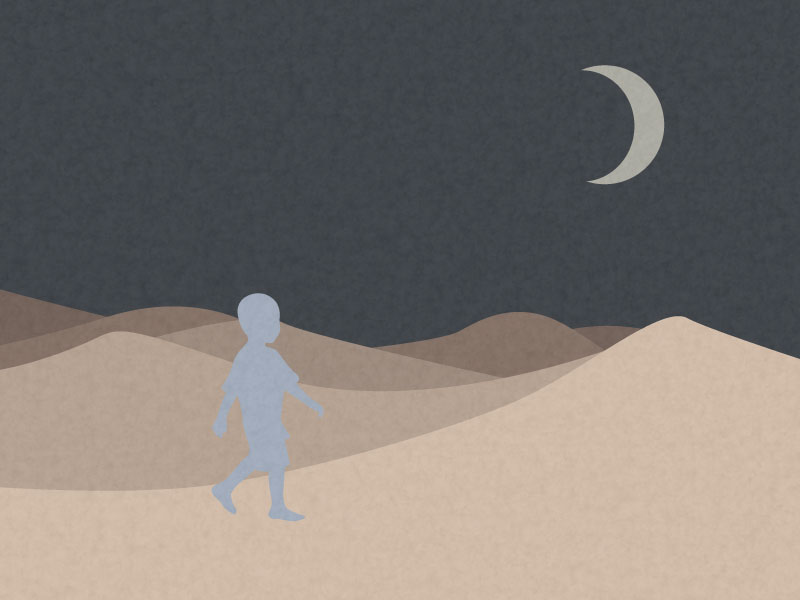I stumble out of the car, my eyes a ruin of strobing lights that fizzle and pop every time I blink. At the last intersection we’d been stopped behind an SUV flashing its hazard lights, a habit among drivers in Saudi Arabia as soon as a few raindrops begin to fall, and I have to wait for my eyes to clear before the dark streets of the Al Khobar souq take shape. Overhead, the night sky is thick with clouds.
We begin to walk. Dress Land, Bombay Fashion, Madina Restaurant, Fresh Fish Center, Golden Juice, the signs beckon in Arabic, Urdu, and Hindi. In the midst of the crowd, I spot a father walking with his three little girls, each in a saffron yellow shalwar kameez. Two boys on a bike, one pedaling, the other standing on the struts, weave in and out of traffic, hollering at everyone they see. We enter a leather goods shop where rows of hand-tooled sandals sweep up the walls to the ceiling and a cobbler sits cross-legged in the corner, surrounded by his tools and stray bits of leather. He introduces himself and dashes across the street to a cafe, returning with three paper cups of steaming chai.
While we sip the tea, he works a stiff thread through the sole of a shoe and tells us that he left his home in Peshawar 25 years ago and has been working in Khobar ever since. When he arrived, he says, the buildings were shorter and there wasn’t as much traffic. He laughs and tells us that sometimes he forgets it is the same city that he remembers from his youth. As we talk, men filter in and out of the store, bringing belts and wallets in need of repair. We make our purchase and step back into the night.
In 1938 oil was discovered in the Eastern Province of Saudi Arabia and Khobar began its meteoric evolution from a sleepy fishing hamlet into a hub of commerce and industry. My family has lived in the Eastern Province for 60 years; flip through family photo albums and the succession of images shift from black-and-white to color as Khobar transforms from a dusty town with a single paved road into a sprawling metropolis with chockablock highways. But behind the banal bloat of international chain stores and fast food restaurants, the shadowy alleys of Khobar’s souq remain dense with strangeness. These disheveled lanes are the sight of my most potent childhood memories and for weeks something has been tugging at me to make a pilgrimage along the ley lines of my youth.
Most of the people we pass are Indian, Pakistani, or Bangladeshi, who meander slowly down the streets in small groups of men or families, enjoying the winter evening. It rained earlier and the excitement of this rare delight still shivers through the air. Children slip in and out of doorways, sandals slapping sharp rhythms against the sidewalk. A truck roars past and my abaya catches in its wake, flaring around my knees, and I spin in a circle, pushing it back down. On one corner, a group of men take up half the sidewalk playing a game of karom, flicking the pieces with snapping fingers. We pass a shop plastered in fliers advertising shampoo and nuts, where blonde dolls with sun-bleached faces fill the windows.
Iain Sinclair has said that the solitary walker is followed by a ghostly contingent of other walkers who murmur in his ear, trying to tempt him down one path or another. For me, these whispering stalkers aren’t strangers but family members; these aren’t just the streets of my childhood, they are the streets of my parent’s childhood, as well. We are Americans who call Saudi Arabia ‘home’.
My father grew up in a tiny refinery town further up the coast and as a child he viewed Khobar as a booming metropolis. He and his family would have to take long, un-air-conditioned bus rides whenever they wanted to visit, but it was worth it to reach the city where everything happened first, fastest, and best. He recalls the sweltering summer day he watched as one of the country’s first bulk refrigerators was installed, slipping into the shop afterward to marvel at the frigid air. And the day in 1960 when Ethiopian Emperor Haile Selassie came to town and my father watched as he and King Saud swept by in their gleaming military escort. Later that decade were the high-octane chases running from scissor-wielding mutaween, the Kingdom’s religious police, who chased any kid they saw sporting the popular Beatles’ mop-top hairdo.
Growing up with these stories, and the stories of my mother and grandparents, made for me a Khobar that exists in multiplicity with itself. Wherever I go, I’m never just in the Khobar of today, but in the Khobar of so many yesterdays, my vision marred by the manifold memories. Sometimes I think I know this city too well to ever experience it directly; instead, I traverse a gauzy assemblage of recollections, navigating on a level quite distinct from mundane topography.
While riding these slipstreams of memory, I sometimes stumble upon a remnant of my old self preserved between their amber-like layers. Was I ever really this gap-toothed, horse-mad little girl or this surly, chain-smoking teenager? And if our past selves seem to have disconcertingly little bearing on who we are today, what then is the essential part of us that remains intact as life’s changes buffet our more superficial self to and fro? If there is some unchanging splinter of being at our core, an internal compass rose that keeps us locked into a particular trajectory, then I think maybe it is built out of the story we tell about our life; a self-aware myth that knits together the disparate vagaries of a human existence into a single coherent narrative. We cling to it and insist, “This is me. This is who I really am.”
We’ve reached one of my least favorite parts of the city, filled with brutalist architecture tossed up in the 1970s oil boom heyday. Tall pale buildings with sun-blistered facades form gargantuan cathedrals over the intersections, a grim malevolence sheening off their regimented black windows. It is impossible to feel human while walking beneath them. The always-threatening abyss of modernity, that insistent nihilistic bleat behind the eyelids, feels closer to the surface here than it does in other places. We hurry on.
We have been walking for a few hours and my circle of focus has gradually receded until I have become a pillar of pure biological need. We poke our heads into a few teashops and restaurants but when they realize we’re asking for a female bathroom, the answer is always la. So, we make our way down Custodian of the Two Holy Mosques Road toward the corniche, where cold, salty wind blows in from the dark sea. We pass a group of men gathering to pray beneath a thatched gazebo, a fact that does not bode well for my now desperate need for a bathroom. When we reach the first restaurant, a palatial Pizza Hut, my fears are confirmed; the doors are locked and will remain that way until prayer time is over. For the next twenty minutes, I try to think of anything but the oceanic sloshing just beyond the glow of the streetlights.
The moment the doors are unlocked I rush inside, where I’m met by the shouts and waving hands of frantic employees. In my desperate haste I’ve accidentally entered the men’s section and I have to leave and go around to the family section, where women, and men accompanied by female family members, are allowed. As I scurry around the building, I think to myself that in Saudi Arabia it is impossible to forget about sex. There are signs everywhere that funnel people along their chromosomally sanctioned pathways, with different checkout lines in stores, different waiting rooms in clinics, and different sections in restaurants where desperate women may lunge for any door that could lead to a toilet.
Relief achieved, a bottle of water purchased, we cross the highway and plunge into the other side of the souq, where things are livelier and a tinge of sharp-elbowed fervor permeates the sidewalks. We pass Filipino bakeries and tailors, and every street corner is plastered with fliers advertising spare rooms – Roommate Wanted – Pinoy Only. In front of a barbershop two men sit on the curb playing the fastest game of chess I’ve ever seen, their hands slapping the timer in a frenzied blur. A soft trickle of music seeps out from a tiny vegetable shop. I peek inside – there seem to be more fluorescent light bulbs on the ceiling than actual ceiling – and find a wall-mounted TV showing shaky footage of some festival where men in luminous bone-white thobes are dancing the <ardah, Saudi Arabia’s traditional dance. They shuffle from side to side, janbiya swinging at their hips, to the insistent beat of a drum. Every so often one of them drifts away from the group to talk on his cell phone or take a smoke break. The shopkeeper, a red and white gutra perched low on his forehead, gives me a toothless grin, a stick of bristly miswak wedged between his gums. I say masa’ al-khair and he presses a hand to his heart, closes his eyes, and gives me a bow.
On the next block we find a rug shop where mountains of rugs sprawl across the canopy-covered sidewalk. An Afghani tribal rug hanging by the door shows images of tanks, soldiers, and guns. At the top is an image of the Twin Towers and a date: 9/11/2001. Below is a stylized map of Afghanistan filled with troops and American flags. Along the bottom it reads: “Long Live American Soldiers!” The shopkeeper sees me looking and leans out to say, “In Afghanistan, we used to have only three languages: Arabic, Pashto, and Taliban.” He chuckles at his own joke and ducks back inside.
A soft rain begins to fall and we walk on as the street closes in around us, like a bird quieting for the night. And then, there it is: the shop we call the Time Warp Toy Store. Enter and it is 1983. He-Man reigns supreme. Barbie has crimped hair and dangerously sharp shoulder pads. I pick up a puzzle, on the side of the box a stamp reads: Made in West Germany. The bounds of temporal reality are useless here; time rolls toward the shop, hesitates, and turns back. Almost unknown to modern kids who prefer the well-worn routes of shopping malls, this toy store is enshrined in the memory of older generations who remember a time when malls were something we had to leave the country to visit.
The shop is owned by a handful of Yemeni brothers who wanted a place to socialize more than they needed a booming commercial enterprise. As a child, a trip to the store was incomplete until one of the old men lounging in the corner laughed at the way you pestered your parents for whatever toy was that month’s necessity. They wore dark thobes and were never without a cigarette and thimbleful of steaming tea. Clacking away in their fingers, prayer beads.
As an adult, my father once purchased a model airplane from the Time Warp Toy Store. When he paid, he laughingly told one of the brothers that when he first saw the toy, thirty years ago, it had only cost 4 riyals, whereas now the price was 24. Without missing a beat the owner replied: “If you give me back those thirty years, I’ll give you back your twenty riyals.”
Through the dim and cluttered aisles we roam, unearthing treasures from decades past. Here is a kit so you can put together your very own Challenger Shuttle model. Here is Home Office Barbie, Astronaut Barbie, and Totally Hair Barbie. And here is a replica Patriot Missile launcher I would have loved to have when I was a child dragging my gas mask to and from school during the 1st Gulf War. Eventually, we pay for our nostalgic purchases and step back outside where we find the rain has been replaced by a cloud of fog that coats the street in a watercolor haze.
Suddenly, like sometimes happens when I’m walking these streets, I am overcome by the weight of a lifetime of memories, a heavy certitude of belonging that I tell myself must be what home feels like. And, as always, just as quickly comes the follow-up feeling of dull panic, because no matter how much my memory insists this is my home, I know in reality that isn’t possible. I can’t become a citizen and as an expat I won’t be allowed to live here indefinitely. At any time I might have to leave at a moment’s notice, never able to return. Somehow, this terrible tenuousness has become an integral facet to my sense of home and I exist in a constant state of perpetually refreshing nostalgia, missing things before I’ve left and claiming for my home a city I can never truly call my own.
We head back to the corniche, stepping off the petunia-lined walkway and sinking into the soft white sand. I am reminded of a Saudi folk story about a little Bedouin boy who left his family tent one night, despite being told not to by his parents. He sneaks away into the dunes because the wind sounds like someone calling his name. The boy never finds anyone and by the time he finally returns to his family’s tent, he discovers that decades have passed in his absence and his family is now changed beyond recognition. They don’t recognize him and will not accept him.
The moral of the story is in keeping with traditional Saudi values: in your search for external fulfillment, don’t forget what is truly important – family, custom, and home. But there is something else, something in the way that the boy returns. He comes home expecting to find everything as he left it and it might be that it is his shouts of anger and disbelief that disturb his family, for it is only after he has made a fuss that they cast him out. Maybe it is his refusal to accept the shifting reality of his world that condemns him to never find acceptance within it again.
It is a lesson from the desert that I translate for these quickly changing streets – hold lightly to the warp and weft of reality, lest you be cast out. Accept the strangeness you find, even though it stings. Remember that just like us, cities too have their stories of self, and though they may have a harder time sharing them, they do tell us, nonetheless, and then it is up to us to navigate their swiftly shifting currents.
The need I’ve been feeling to revisit these old streets feels settled here on the beach, drowned out by the roar of the waves and the inky smell of the water. Leaving the caul of memories to the city that looms at our back, we drift away from the glow of streetlights and walk across the sand, toward the beckoning darkness and the black rolling sweep of incoming tide. •
Feature image courtesy of Ziad. Second image courtesy of 4theFAM via Wikimedia Commons. Other images courtesy of Shannon Sands.








